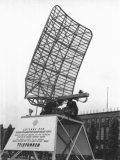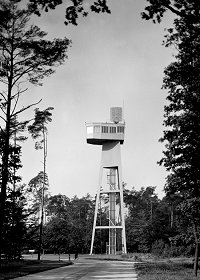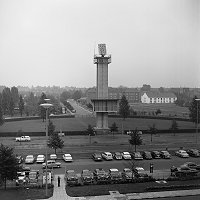Airfield Surveillance Radar ASR 3
Description of the radar set, tactical-technical characteristics

Bild 1: Antenna of the ASR 3 (© AEG Telefunken)
| Specifications | |
|---|---|
| frequency: | 2 700 - 2 900 MHz |
| pulse repetition time (PRT): | 833 µs |
| pulse repetition frequency (PRF): | 1200 Hz |
| pulsewidth (τ): | 0.833 µs |
| receive time: | |
| dead time: | |
| peak power: | 500 kW |
| average power: | 500 W |
| instrumented range: | 54 NM (≙ 100 km) |
| range resolution: | 410 ft (1/16 NM) |
| accuracy: | |
| beamwidth: | 2.5 degrees |
| hits per scan: | |
| antenna rotation: | 25 rpm |
| MTBCF: | |
| MTTR: | |
Airfield Surveillance Radar ASR 3
The Antenna of the Airfield Surveillance Radar ASR 3 was presented on an exposition in Berlin in 1953. First international installation was on Airport Bombay (India) in 1961.
Plan position indicators (PPI's) with a cathode-ray-tube diameter of 10" were used with rotating deflection coils. Azimuth information was derived from servo control voltages. The radar was fitted with a Moving Target Indication (MTI) system using the Pulse-Pair Processing. As electrical delay lines of this length with a sufficient bandwidth and low attenuation were not available at that time, the echo signals were piezo-electrically transformed into acoustic signals. These acoustic signals passed through a mercury-column and then were piezo-electrically changed back into electric signals. By subtracting the signals from the delayed channel from the actual echo signals fixed targets are cancelled with a subclutter visibility of 15 up to 20 dB.
Picture gallery of ASR 3

Figure 2: ASR 3 Tower
at Airport Frankfurt (Main)
(© DFS Deutsche Flugsicherung)

Figure 3: ASR 3 Tower
at Airport Hamburg
(© DFS Deutsche Flugsicherung)

